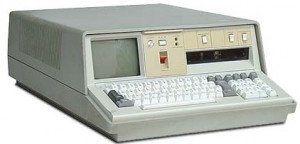on October 26 | in All, Technology | by Doriane Mouret
The tech world will always remember October 2011 as a sad month in its history. We lost three of the most important innovators and computer scientists in the world, Steve Jobs, Dennis Ritchie, and more recently John McCarthy. If we all have a good idea of who Steve Jobs is, not all of us will know Dennis Ritchie and John McCarthy. A a quick reminder, John McCarthy is the inventor of the Lisp programming language and was also a major contributor in the field of Artificial Intelligence. In 2001, he wrote a story, The robot and the baby, that anticipated several aspects of the Internet culture and social networking field as we know them today. As for Dennis Ritchie, he is the creator of the C programming language, a language designed in the early 1970’s to implement system and application software. It is one of the most widely used programming languages of all time.
Steve, John and Dennis changed the world. They thought out of the box and imagined new ways for us to interact with technologies and with each other. Before them, technologies were not adjusted to perfectly satisfy human needs. They created solutions that made technology closer to our expectations. Yet, however brilliant and innovative their findings were, users still need to endeavor to use the tools. And this is what the new century is going to change. The next innovations won’t require us to adapt to them: instead, they will adapt to us.
One Device = One Task
 Let’s get back to 1975, a few months before the beginning of the “Personal Computer” era. While IBM is building the first consumer microcomputer ever – the IBM 5100 -, the common run of people has to use a bunch of different tools to get things done. Need to find information about a specific subject? Open an encyclopedia. Want to write a letter? Use a pen and a piece of paper, or a typewriter if you have one. Thinking about calling a friend? The good old fixed phone will help you with that. Thus, until the beginning of the 1980’s, each human need is answered by a single dedicated tool.
Let’s get back to 1975, a few months before the beginning of the “Personal Computer” era. While IBM is building the first consumer microcomputer ever – the IBM 5100 -, the common run of people has to use a bunch of different tools to get things done. Need to find information about a specific subject? Open an encyclopedia. Want to write a letter? Use a pen and a piece of paper, or a typewriter if you have one. Thinking about calling a friend? The good old fixed phone will help you with that. Thus, until the beginning of the 1980’s, each human need is answered by a single dedicated tool.
But Steve Jobs and Bill Gates are working on it and while you struggle to catch your encyclopedia when on the phone with your mum, they are thinking about how to gather everything in one place. Bill works with Paul Allen at developing a software to put on the new IBM computers. Steve and his two friends Steve Wozniak and Ronald Wayne, on their side, imagine something bigger: they don’t want to do the software only, they want to build the computer that will support it, too. It’s the beginning of the personal computer age, where a single device can operate several different tasks.
One Device = Multi-Task
Since the end of the 1970’s, technologies have known an exponential evolution in terms of accessibility and multitasking. From the creation of the Graphic User Interface in 1983 – Apple Lisa – to the brand new Mobile Operating Systems and Cloud-Based Environments, computers have become a tool that we constantly use to satisfy a wide variety of needs: finding information, communicating with each other, creating contents, etc. For the lucky ones with laptops and smart-phones (mobile operating systems), this computer can follow them absolutely everywhere.
This high availability of information is not only drastically changing our behavior as consumers, but is also highlighting an interesting question: what else can be done? We have everything in our pocket! All the things we need can be stored in a device barely larger than our hand. Whatever we need, “there is an app for that”, right? Well, we can do even better, and the future “Steve Jobs” and “Bill Gates” are currently working on it.
No More Device
Yes, all our needs can be satisfied through our computers, laptops and smart-phones. Whatever question we have, Google and/or Facebook have an answer. Even more complex operations such as developing a website, or even an application, are made easy through WordPress, Dreamwaver, Appcelerator or Heroku. Thanks to your devices, you can even access this website and read this article. That’s great indeed.
No, it’s not. Don’t you see the problem here? Try to think out of your box: what do you need to read this article? Your computer. Right. What’s the problem with your computer? Let’s say you don’t have it, how are you going to do? Well, you can not really do without it…

Now let’s say you are in your living room, watching TV, and you suddenly want to go on dorianemouret.com and read an article. You say “Open Browser DorianeMouret.com” at loud and a screen appear on your wall, displaying the home page of this website. Then all you need to do is to move your hands in the air to browse the website and find something interesting to read about. Too futuristic? Not really. It’s called Natural User Interface, and it’s coming very soon.
Natural User Interface, Motion Detection and Voice Recognition Technologies
In 2008, while we were discovering the iPhone 1st generation and Facebook was barely arriving on the European market, Microsoft was working on a new concept called Natural User Interface. A NUI refers to an interface that is invisible to its users and naturally integrated to the users’ environment. It’s as if you had a computer integrated in your table, your wall, your mirror, etc. The first example of NUI developed by Microsoft is Microsoft Surface, a computer integrated in a table. In 2010, Microsoft enhanced the technology with Project Natal (code name soon replaced by Kinect) and the development of Motion Detection. Kinect recognizes users’ movement and translate them into commands on the software. It also includes Voice Recognition, meaning that the software is capable of interpreting a vocal command.
But the best example of voice recognition is the development of Siri, a Voice Detector available on the new iPhone 4S so accurate that it can be interpreted as a demonstration of Artificial Intelligence – it’s obviously not as all the answers given by Siri are actually recorded and programmed.

Now imagine if you had Siri, Kinect and Surface all together: computers would be integrated in your environment, and all you would need would be your voice and your body to create commands that the software can understand. Why would you need your computer anymore? Well, you could still keep it as an antique in your garage: I’m sure it will worth a lot of money as a collector in a couple of decades.
Yes, computers will soon disappear as a separate entity to naturally integrate in our environment. We still need a few more years to increase software capabilities and make it so small that it’s invisible, but it’s coming. Soon, you will go to the restaurant, and instead of reading a printed menu and using your phone to check-in, you will activate a software integrated in your table that will not only display the menu, but will also tell you if some of your Facebook friends already came here, what they liked and what they didn’t, what people are saying about the place on Yelp, or who’s the mayor on Foursquare.
Yet, the concept of a separate device will remain: we will still need a device for the software to “recognize” us – how can it tell you what your Facebook friends ordered in the restaurant if it doesn’t know who you are? – but it will only be an authentication device, probably smaller than a chip, that you will carry in your clothes, as a jewel, or maybe under your own skin. Scary right? Well remember that few years ago, we thought that revealing our marital status to our coworkers was an attempt to privacy, and today we let them see our private pictures on Facebook. It’s all about adaptation. We are not ready for it, but when it comes, we will be.
Here is a short video of NUI currently developed by Microsoft and that will be available to the general public in 2019, which means in 7 years. Get ready!
I hope this first “Technology” article did make you think “out of the box” and predict the future. If not, it’s probably because your reflection is going further than mine, and I would love to hear it in the comments! Also, as a former Microsoftee, I have a lot of resources regarding Microsoft, but if you have any information about Apple, Google, Facebook or any promising start-up working on a revolutionary NUI, I would love to hear it too. Thanks for reading!
» All, Technology » Enjoy Your Computer: It Will...
« Social Media Strategy: Expose, Influence, Engage 3 New Social Networks You Will Hear About Soon »